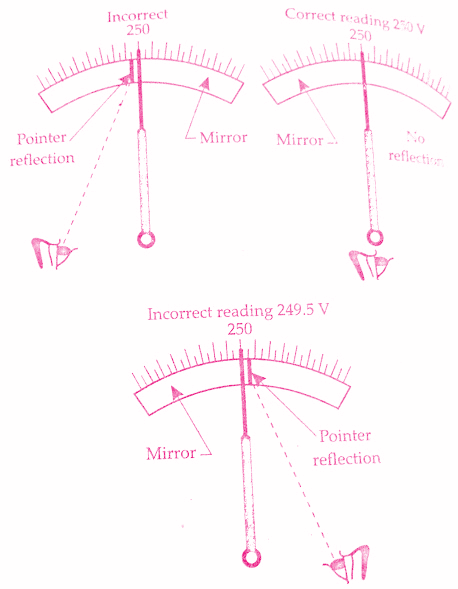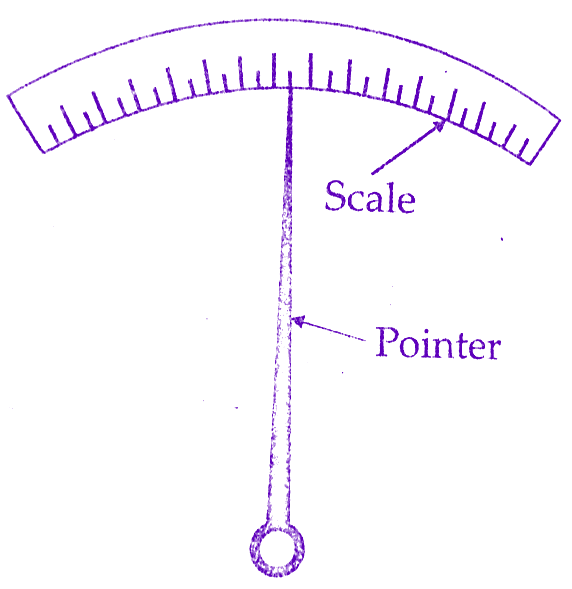Different Types of Errors in Electrical Measuring Instruments
No electrical measuring instrument can be made with perfect accuracy but it is important to find out what accuracy actually is and how different types of errors have entered into the measurement (actual reading): A study of errors is a first step in finding ways to reduce them. Errors may arise from different sources and are usually classified as under :
(1)Gross Errors
(2)Systematic Errors
(3)Random Errors
(1)Gross Errors in Electrical Measuring Instruments:
This class of errors mainly covers human mistakes in reading measuring instruments and recording and calculating measurement results. The responsibility of the mistake normally lies with the experimenter. The experimenter may grossly misread the scale.For example, he may, due to an oversight, read the temperature as 31.5°C while the actual reading may be 21.5°C. He may transpose the reading while recording.
For example, he may read 25.8°C and record 28.5`C instead.But as long as human beings are involved, some gross errors will definitely be committed.Although complete elimination of gross errors is probably impossible, one should try to anticipate and correct them.Some gross errors are easily detected while others may be very difficult to detect.
Must Read:
Gross errors may be of any amount and therefore their mathematical analysis is impossible. However, they can be avoided by adopting two means. They are :
1. Great care should be taken in reading and recording the data.
2. Two, three or even more readings should be taken for the quantity under measurement.
These readings should be taken preferably by different experimenters and the readings should be taken at a different reading point to avoid re-reading with the same error.It should be understood that no reliance be placed on a single reading.It is always advisable to take a large number of readings as a close agreement between readings assures that no gross error has been committed.
(2)Systematic Errors in electrical measuring instruments:
These types of errors are divided into three categories
(i)Instrumental Errors
(ii)Environmental Errors
(iii)Observational Errors
(i)Instrumental Errors
These errors arise due to three main reasons :
(a) Due to inherent shortcomings in the instrument
(b) Due to misuse of the instruments
(c) Due to loading effects of instruments
(a)Inherent shortcomings of instruments: These errors are inherent in instruments because of their mechanical structure.They may be due to construction, calibration or operation of the instruments or electrical measuring devices.These errors may cause the instrument to read too low or too high.For example, if the spring (used for producing controlling torque) of a permanent magnet instrument has become weak, the instrument will always read high. Errors may be caused because of friction, hysteresis or even gear backlash.
While making precision measurements, we must recognise the possibility of such errors as it is often possible to eliminate them, or at least reduce them to a great extent by using the following methods :
(i) The procedure of measurement must be carefully planned. Substitution methods or calibration against standards may be used for the purpose.
(ii) Correction factors should be applied after determining the instrumental errors.
(iii) The instrument may be re-calibrated carefully.
(b)Misuse of instruments: There is an old saying that instruments are better than the people who use them. Too often, the types of errors caused in measurements are due to the fault of the operator than that of the instrument.
A good electrical measuring instrument used in an unintelligent way may give erroneous results. Examples which may be cited for this misuse of the instrument may be a failure to adjust the zero of instruments, poor initial adjustments, using leads of too high a resistance etc.
No doubt the above improper practices may not cause a permanent damage to the instrument but all the same, they cause errors.However, there are certain ill practices like using the instrument contrary to manufacturer’s instructions and specifications which in addition to producing errors cause permanent damage to the instruments as a result of overloading and overheating that may ultimately result in failure of the electrical measuring instrument and sometimes the system itself.
(C)Loading effects: One of the most common errors committed by beginners is the improper use of an instrument for measurement work.For example, a well calibrated voltmeter may give a misleading voltage reading when connected across a high resistance circuit.The same voltmeter, when connected in a low resistance circuit, may give a more dependable reading.These examples illustrate that the voltmeter has a loading effect on the circuit, altering the actual circuit conditions by the measurement process.
Therefore errors caused by loading effects of the meters can be avoided by using them intelligently.For example, when measuring a low resistance by ammeter-voltmeter method a voltmeter having a very high value of resistance should be used.In planning any measurement, the loading effect of instruments should be considered and corrections for these effects should be made, if needed, or more suitable electrical measuring instruments should be used. Preferably those methods should be used which result in negligible or no loading effects.
Must Read:
(ii)Environmental Errors:
These errors in electrical measuring instruments are due to conditions external to the measuring device including conditions in the area surrounding the instrument.These may be effects of temperature pressure, humidity, dust, vibrations or of external magnetic or electrostatic fields.The corrective measures employed to eliminate or to reduce these undesirable effects are :
1. Arrangements should be made to keep the conditions as nearly as constant as possible. For example, the temperature can be kept constant by keeping the equipment in a temperature controlled enclosure.
2. Using equipment which is immune to these effects. For example, variations in resistance with temperature can be minimised by using resistance materials which have a very low resistance temperature coefficient.
3. Employing techniques which eliminate the effects of these disturbances. For example, the effect of humidity dust etc. can be entirely eliminated by hermetically sealing the equipment.
4. In case it is suspected that external magnetic or electrostatic fields can affect the readings of the electrical measuring instruments, magnetic or electrostatic shields may be provided.
5. Applying computed corrections: Efforts are normally made to avoid the use of application of computed corrections, but where these corrections are needed and are necessary, they are incorporated for the computations of the results.
(iii)Observational errors:
There are many sources of observational errors.As an example, the pointer of a voltmeter rests slightly above the surface of the scale. Thus an error on account of PARALLAX will be incurred unless the line of vision of the observer is exactly above the pointer. To minimise parallax errors, highly accurate meters are provided with mirrored scales, as shown in the figure ‘errors due to parallax’.
When the pointer’s image appears hidden by the pointer, observer’s eye is directly in line with the pointer.Although a mirrored scale minimises parallax error, an error is necessarily present though it may be very small.Since the parallax errors arise on account of the pointer and the scale not being in the same plane, we can eliminate this error by having the pointer and the scale in the same plane as shown in figure arrangements showing scale and pointer in the same plane’.
 |
| Errors due to parallax |
There are human factors involved in measurement.The sensing capabilities of individual observers affect the accuracy of measurement.No two persons observe the same situation in exactly the same way where small details are concerned.For example, there are observational errors in measurements involving timing of an event.One observer may tend to anticipate the signal and read too soon.
Different experimenters may produce different results, especially when sound and light measurements are involved since no two observers possess the same physical responses.Modern electrical instruments have a digital display of output which completely eliminates the errors on account of human observational or sensing powers as the output is in the form of digits.
 |
| Arrangements showing scale and pointer in the same plane |
(3)Random(Residual) Errors in electrical measuring instruments: :
It has been consistently found that experimental results show variation from one reading to another, even after all systematic errors have been accounted for.These types of errors in electrical measuring instruments are due to a multitude of small factors which change or fluctuate from one measurement to another and are due surely to chance.The quantity being measured is affected by many happenings throughout the universe.
We are aware of and account for some of the factors influencing the measurement, but about the rest we are unaware.The happenings or disturbances about which we are unaware are lumped together and called “Random” or “Residual”.Hence the errors caused by these happenings are called Random (or Residual) Errors.Since these type of errors remain even after the systematic errors have been taken care of, we call these errors as Residual (Random) Errors.
Conclusion:
Now here we have discussed the different types of errors in electrical measuring instruments like gross errors, systematic errors, random errors etc,.You can download this article to your device as pdf, ppt.
Comment below for any Queries.

Truly helpful. I like and love it